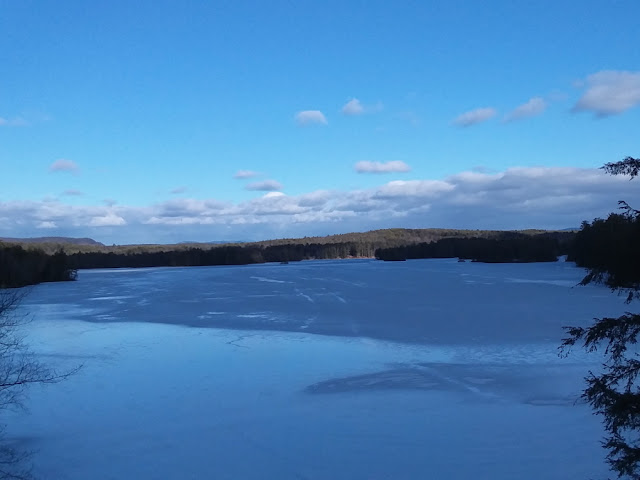I hope everyone had a wonderful Christmas - even if you were in the rain-drenched New England area. Around the Lakes Region we had enough snow from the last storm to outlast the rain and keep the ground white, but our three foot dump is down to a third of that now. Skiing will be on hold until we receive a new freshening of powder, but a quick freeze after the rain means that skating might be in order.
Before the warm front arrived I'd been out to several different areas around the lakes and everywhere I went I found a plethora or deer tracks, so one afternoon I decided to follow some of our local deer to see what they were up to. It was interesting to note the different forms the tracks took. The oldest tracks were those set right after the deep snow fell. It was so light and deep that their skinny little hooves sunk so deep down that their bellies dragged along, plowing a trough in the snow.
 |
| Even with those long legs they plowed a trough through the snow. |
A day or two later, using the same path they had plowed out previously made their travel easier and left fresh tracks on top of their previous route.
 |
| Reusing a pre-packed trail. |
The third variant I saw was the freshest, probably made the day I was out. The snow had packed down enough that they left more traditional tracks in deep soft snow.
Even through deep snow deer are able to sniff out stashes of acorns under the oak trees, and dig down to ground level to extract these high-energy food sources.
 |
| Pawing down into the leaves for a meal of acorns. |
After following along for a distance I came to a clue that I was probably tracking our mom and her two yearlings.
 |
| Two small melted-out beds and a bigger one for mom, all under the cover of hemlock branches. |
 |
| The snow had melted right down to the ground. |
This looks to me like a spot where the three of them bedded down for a nap, or maybe even to spend the night. The melted snow tells me this wasn't digging for acorns but rather they spent a fair amount of time here. I hope they have grown their warm fur coats by now.
I kept my eye out for signs of tree browse but didn't see any evidence of that. But they did leave plenty of evidence along the trail that they have been eating!
Sadly, there are down sides to living close to all this nature. Those deer completely decimated one of Linda's hydrangeas that was exposed once the snow melted down.
 |
| How sad a sight is that. |
It's a reminder that we are living in their world.
I did get out yesterday to cut a hole in the ice close to shore and found it to be six inches thick, about half black ice and half white ice, which is safe enough for foot travel - at least where it's that thick. But it was treacherous finding a way from shore to solid ice as the entire shoreline had melted out. I'll wait for a couple more days of cold temps before I try out the surface condition for skating.













































